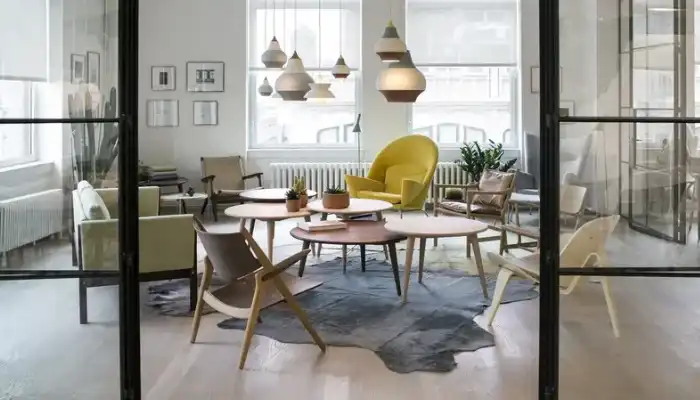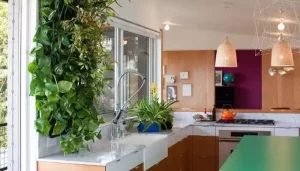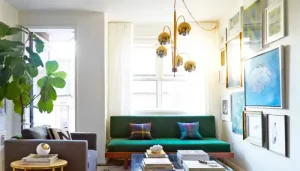Scandinavian design, characterized by its clean lines, functionality, and embrace of natural elements, has become a cornerstone of modern home décor. But where did this aesthetic originate, and how has it evolved over time to remain so relevant? This guide delves into the history and enduring influence of Scandinavian design, offering insights into its core principles and lasting impact on how we create our living spaces.

A Design Movement Rooted in Simplicity
Scandinavian design emerged in the mid-20th century, encompassing the design philosophies of Denmark, Sweden, Norway, Finland, and Iceland. Born from a desire for simplicity and functionality in a region with long winters and limited daylight, this movement emphasized:
- Clean lines and uncluttered spaces: A rejection of ornate Victorian styles dominated the era, replaced by a focus on clean lines and uncluttered layouts.
- Functionality at the forefront: Every piece of furniture served a purpose, with an emphasis on versatility and space-saving designs.
- Natural materials: Wood, wool, leather, and cotton were heavily favored, reflecting a connection to nature and a preference for honest materials.
Evolution Through the Decades
While the core principles of Scandinavian design remain, it has adapted and evolved over time:
- Mid-century Modern: The 1950s and 1960s saw Scandinavian design gain international recognition, becoming a key component of the mid-century modern movement. Furniture icons like the Eames Lounge Chair and the Wegner Wishbone Chair became symbols of sleek elegance and functionality.
- Global Inspiration: Scandinavian designers began incorporating influences from other cultures, resulting in a more eclectic yet still minimalist aesthetic. Japanese design principles, with their emphasis on clean lines and natural materials, became a significant influence.
- Modern Interpretations: Today, Scandinavian design continues to inspire contemporary home décor. Modern interpretations embrace lighter wood tones, pops of color, and a focus on sustainable materials.
The Pillars of Scandinavian Design
Let’s delve deeper into the core elements that define Scandinavian design and contribute to its enduring appeal:
- Minimalism and Simplicity: Scandinavian design champions the “less is more” philosophy. Clean lines and uncluttered spaces create a sense of calm and serenity, allowing the natural beauty of the materials to shine through.
- Functionality and Practicality: Every piece of furniture serves a purpose, with an emphasis on multifunctionality and space-saving designs. This focus on practicality makes Scandinavian design ideal for modern living, where space is often at a premium.
- Natural Materials: Wood, particularly light-colored woods like ash and beech, take center stage. Wool, leather, and cotton textiles add warmth and texture. The use of natural materials creates a connection to nature and fosters a sense of well-being.
- Light and Space: Maximizing natural light is paramount in Scandinavian design. Large windows, light walls, and strategic use of mirrors create a sense of openness and airiness, even in smaller spaces.
A Legacy of Timeless Style
The influence of Scandinavian design on home décor is undeniable. Here’s how it left its mark on the world:
- The Mid-Century Modern Movement: Scandinavian design became a defining characteristic of the mid-century modern movement, influencing furniture design, architecture, and even graphic design.
- Global Reach: Scandinavian design principles spread internationally, inspiring designers and homeowners around the world to embrace simplicity, functionality, and natural materials.
- A Constant Presence: Scandinavian design continues to be featured in prominent home décor magazines and exhibitions. Its timeless elegance and adaptability ensure its enduring relevance.
The Enduring Allure: Scandinavian Design in a Modern World
Scandinavian design, with its emphasis on clean lines, functionality, and natural materials, has captivated the world for decades. But how does this design aesthetic fare in the ever-evolving landscape of home décor? Is it merely a passing trend, or does it hold the key to creating timeless and inviting living spaces? Let’s delve into the current trends in Scandinavian design, explore the challenges it faces, and examine its potential for the future.
Scandinavian Design in the Modern Home: A Shift in Preferences
Scandinavian design has undergone a subtle yet significant transformation in recent years. Here’s a glimpse into some key trends:
- Beyond Minimalism: While clean lines and a minimalist approach remain core principles, a touch of warmth is creeping in. Expect to see more textured fabrics, organic shapes, and pops of color alongside the classic white and neutral palettes.
- Scandinavian Comfort: Functionality remains paramount, but comfort takes center stage. Think plush armchairs, inviting throws, and an overall focus on creating a cozy and relaxing atmosphere.
- Japandi Fusion: The minimalist sensibilities of Scandinavian design are merging with the wabi-sabi philosophy of Japanese aesthetics. This fusion emphasizes natural materials, handcrafted elements, and a celebration of imperfection.
A Look at Scandinavian Elements
The enduring appeal of Scandinavian design lies in its core principles:
- Functionality First: Every piece of furniture serves a purpose. Form follows function, resulting in streamlined designs that are both beautiful and practical.
- Natural Materials: Wood, wool, and cotton reign supreme. These natural elements bring warmth, texture, and a connection to nature into the home.
- Light and Airy Appeal: Scandinavian design prioritizes maximizing natural light and creating a sense of spaciousness. This is achieved through open floor plans, light colors, and strategic use of mirrors.
Table 1: Key Elements of Scandinavian Design
| Element | Description | Example |
| Functionality | Every piece serves a purpose | A dining table with hidden storage compartments |
| Natural Materials | Wood, wool, and cotton are prioritized | A plush wool rug with a geometric pattern |
| Light and Airy Appeal | Focus on maximizing natural light | Large windows with sheer white curtains |
Sustainability and Eco-Consciousness
Sustainability is a major driving force in contemporary design, and Scandinavian design readily embraces this trend. Here’s how:
- Focus on Quality and Durability: Scandinavian furniture is built to last, reducing waste and promoting mindful consumption.
- Sustainable Materials: The use of recycled materials and ethically sourced wood is becoming increasingly common.
- Timeless Design: Classic Scandinavian pieces remain relevant for years, discouraging the need for frequent replacements.
Challenges and Criticisms
Despite its widespread popularity, Scandinavian design isn’t without its critics:
- Homogeneity and Lack of Diversity: Some argue that the clean lines and minimalist aesthetic can create a sense of uniformity across different homes.
- Pricing and Accessibility Concerns: High-quality Scandinavian furniture can be expensive, potentially limiting accessibility for budget-conscious homeowners.
- Balancing Tradition with Innovation: Preserving the core principles while incorporating contemporary elements and personal touches remains a challenge for some.
The Future of Scandinavian Design: Evolution and Adaptation
Despite these challenges, the future of Scandinavian design seems bright:
- Enduring Principles: The core principles of functionality, natural materials, and light-filled spaces remain timeless and relevant.
- Integration with Emerging Trends: Scandinavian design can readily adapt to contemporary trends like sustainability, Japandi fusion, and the embrace of comfort.
- Cultural Hybridization and New Interpretations: As cultures and design influences continue to interweave, expect exciting new interpretations of Scandinavian aesthetics.
Conclusion
Scandinavian design has transcended a mere trend, establishing itself as a design philosophy that prioritizes functionality, comfort, and a connection to nature. Its adaptability allows it to evolve alongside modern preferences, ensuring its continued relevance in the ever-changing world of home décor. The future holds exciting possibilities for the hybridization of Scandinavian design with emerging trends, paving the way for a new generation of beautiful and functional living spaces.


